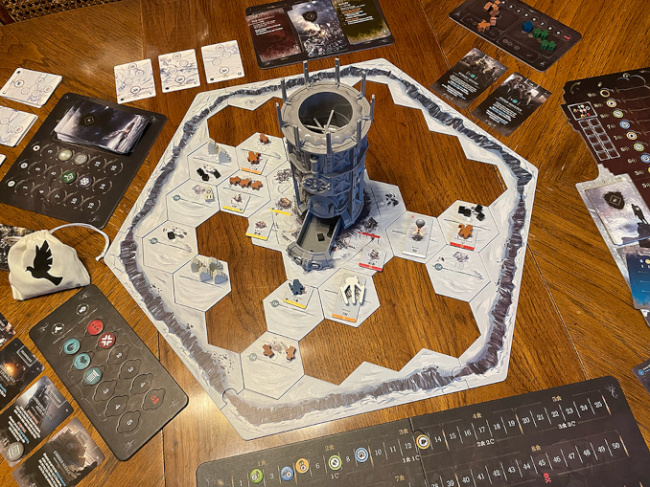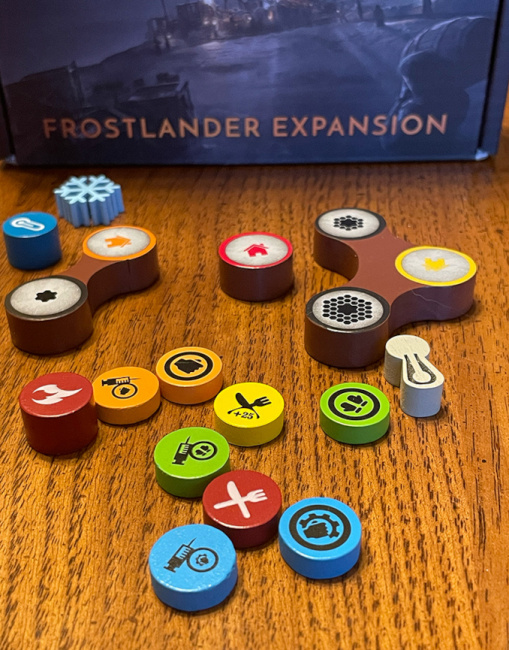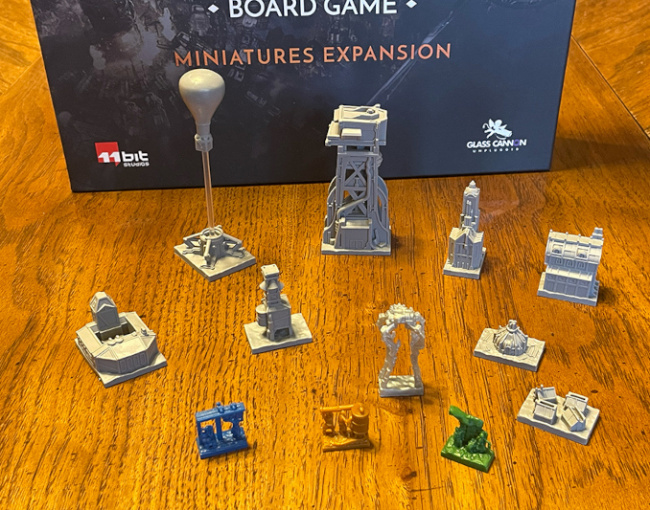Frostpunk: The Board Game (plus Frostlander Expansion and Miniatures Expansion)
Publisher: Glass Cannon Unplugged
Release Date: March, 2023
MSRP(s): Base Game: $119.99; Frostlander Expansion: $24.99; Miniatures Expansion: $90.00
Number of Players: 1-4
Product #(s): Base Game (FPBG01); Miniatures Expansion (FPBG03); Frostlander Expansion (FPBG02)
Age Rating: 18+
ICv2 Rating: 4 Stars out of 5
Living in an age of global warming, it seems a bit ironic to imagine a world faced with global cooling, yet that is exactly what Frostpunk does, first as a video game from 11-bit studios and now a board game from Glass Cannon Unplugged. Combining ecological disaster with steam-punk imagery, the game pits humanity’s survivors against brutal elements and their own darker impulses. But is this a hot idea, or should it have been left in the deep freeze?
Summary: In Frostpunk: The Board Game, the players are the leaders of a small community who survived an ecologic catastrophe that triggered a global ice age. The only thing keeping them from freezing to death is the Generator, a coal-powered heater in the middle of the settlement. By judicious use of their resources and limited supply of workers, they must manage the Generator and their food supplies while maintaining the population’s physical and mental health. If they fail to do any of those, the community fails and they lose. Along the way, they must expand the settlement, dispatch scouts to find resources and other survivors, and deal with their often-fractious people.
Mechanically, the game combines worker placement, resource management, and engine-building in a cooperative framework. The players collectively and individually determine which buildings to add, how to use their limited resources, and how to react to random events. Often, these decisions are harsh, boiling down to deciding who lives and who dies, or which morally-ambiguous path is the least offensive to follow—such as whether to allow child labor or legalize prostitution. Hence the game’s "18+" rating.
Originality: The story of the game is drawn from an existing IP, and the system pulls heavily from a number of well-established styles as well, so a lot of the game may feel familiar. But it still manages to offer some surprises in the way the various elements come together. I think that the game’s most novel feature, which I understand is drawn from the original computer game, is its fearlessness in confronting moral questions head-on. Are the benefits of extra workers worth the social ills brought on by allowing child labor? Is it better to allow some to starve so more skilled laborers can eat? Is doing the "right thing" the right thing to do? Most games shy away from such questions.
Presentation: I think part of the appeal of basing a board game on a computer game is the ability to take advantage of existing artwork and artistic styles. This is done to good effect here, with strong, evocative imagery that captures the gloominess and simmering despair that characterizes the setting. However, the overall result is very dark, especially when it comes to the external packaging. The font used for the title is difficult to read, but the back of the box does a very good job of showing off the game and explaining its concepts. Once set up, the enormous Generator model and stark color palette draws attention and the playspace draws the players in.
Quality: All of the components and packaging are excellent. The very large box is strong, the component tray well designed. The tiles and tokens are good, thick cardboard, the wooden pieces well-made. It has multiple boards that are sturdy and laid out well. The cards are very nice, with both standard-size and tarot-size cards used well. The enormous plastic Generator is well-built and attractively designed, without being a mere decorative piece: it functions as a sort of dice tower that determines how quickly the Generator breaks down as it is force-fed coal to keep the settlement from freezing.
The language on the cards and components is clear and easy to read, and the icons and information on the tokens is well-designed and informative. The rulebook is a lengthy read, but does a good job of explaining the concepts with lots of illustrations. However, I think that it would have benefited from some well-designed examples and maybe a play-through that shows how a few turns would be resolved. We had to do a lot of referencing during play, as the game is quite complex in places, and even after our first full game, we were left feeling that there were some things that we weren’t quite doing right and had some questions that we could not easily answer from the rules.
Marketability: The history of board games based on computer games is mixed, at best, and while there have been improvements, a lot of buyers are hesitant to pick such a game for that reason. That would be unfortunate here. I had only a passing familiarity with Frostpunk before I saw the board game, and I found the experience to be solid despite that. Knowledge of the source is definitely not required. Still, the game is pricy, and at the higher end of complexity, both of which could limit its market. But there is also a lot in the box to justify the price, and a good amount of replayability built in, as well as a strong possibility for solo play.
Overall: Frostpunk is one of the heaviest games I have ever reviewed, both literally and figuratively. This is not a game for the faint of heart. It has a complex ruleset with a lot of interlocking mechanisms that must be managed carefully, and every decision you make is meaningful. The challenges are tight, and it is easy to make a mistake that you may not be able to recover from. Success is very much in doubt to the very end.
In a lot of ways, the game’s strengths are also its weaknesses. It is too heavy to appeal to casual gamers. As a cooperative, it will not appeal to competitive players. With society emerging from pandemic isolation, the fact that it would make a superlative solitaire game is less of a selling point. Nonetheless, I think there are players out there who appreciate a tough, meaty, decision-rich challenge for solo or cooperative play, and Frostpunk is one of the best offerings for that category that I have seen for a while. And that’s why I’m giving this game 4 out of 5.
Expansions
I would also like to make a few comments about the two expansions:
The Frostlander Expansion offers two things that I very much appreciate: upgraded wooden doodads to replace some of the cardboard pieces and additional law, exploration, and event cards. The wooden upgrades really improve the tactile experience of playing the game. Having more cards increases the variability of the game, which in turn extends its replayability. For anyone who likes the game, I can easily recommend this expansion.
The Miniatures Expansion is something that I really like, and that I wish more publishers would consider instead of simply cramming extra over-produced components into a game and raising the base price. The miniatures are gorgeous, nicely sculpted, and very tactile. They do help gameplay by making it easier to see where buildings have been constructed, but they are really only aesthetic: important game information is not printed on them, so we ended up placing them on top of the building tiles that they would replace. What I like about this expansion is that it gives me the choice. The game is perfectly playable without them, but if I want to, I can add them in for a more visual experience. Or not. And I appreciate Glass Cannon letting me make the choice.
Click Gallery below for game and mini pics!

ICv2 Stars: 4 (out of 5)
Posted by William Niebling on March 20, 2023 @ 1:53 am CT







 View Gallery: 5 Images
View Gallery: 5 Images